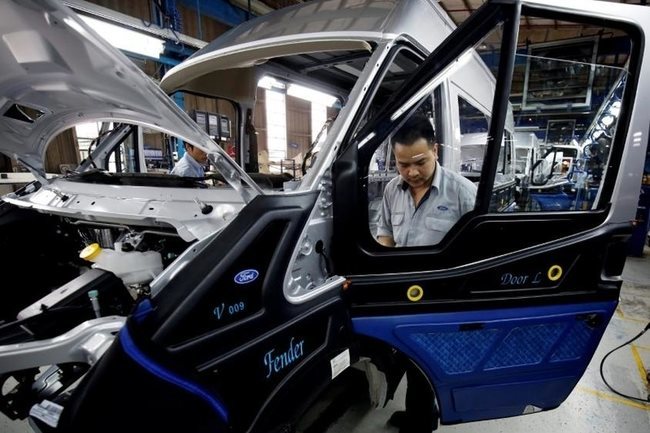 |
|
Laborers work at Ford Vietnam car factory in the northern province of Hai Duong on April 12, 2019. Ford Motors’ intention to expand its Vietnamese plant will provide only a modest boost to the country’s vehicle output over 2020 and 2021 |
The provider of credit and macro intelligence pointed out the influx of imported vehicles, which will erode the demand for locally produced vehicles and lead other automakers to cut output, thereby suppressing the country’s overall passenger vehicle production.
Locally founded in 1995, Ford Vietnam announced on January 14 that it is investing US$82 million to expand its plant in northern Vietnam to increase output. The construction will expand the facility across an additional 60,000 square meters of land, bringing the total area to 226,000 square meters.
This extra investment led the primary distributor of Fitch Ratings content to believe that this expansion will come online, or partially online, by the end of this year.
The automaker also stated that the expanded factory would boost its annual vehicle production capacity to 40,000 units from its current capacity of 14,000 units.
This led Fitch Solutions to raise its passenger vehicle production forecast for only 2021, as the agency believed that output cuts from other automakers in Vietnam will cancel out any growth that would come from Ford’s expansion in 2020.
For 2020, the agency forecast that passenger vehicle production will expand modestly by 3.3%. For 2021, it has raised the growth forecast to 6.8%, up from 2.6%.
“This forecast will depend on the Government’s effectiveness in limiting imports,” noted the agency.
Earlier, Deputy Trade Minister Do Than Hai said he expected the expansion of Ford Vietnam to reduce Vietnam’s reliance on imported vehicles and therefore lower the country’s trade deficit.
Strong demand for imported vehicles
Strong demand for vehicles will be geared toward imported vehicles. Fitch Solutions believed that Vietnam’s automotive market will remain robust in 2020, as an improved credit outlook coupled with globally outperforming economic growth and declining vehicle prices all support higher vehicle demand.
Furthermore, the agency stressed that consumers will look to imported vehicles as their costs are dropping the fastest due to the oversupply of vehicles following the reduction of tariffs on vehicles as part of the ASEAN Trade in Goods Agreement, which was signed in 2009 in Thailand.
The agency forecast passenger vehicle sales would expand by 10.8% this year, following a year-on-year expansion of 19.6%.
“We forecast new passenger vehicle sales will expand by another 10% in 2021 and that new passenger vehicle sales will average annual growth of 7.9% over 2022-2029,” announced the agency.
It predicted a sizable portion of this demand will flow toward imported vehicles over locally produced vehicles.
This means that automakers producing vehicles in Vietnam will cut back on their output as the demand for locally produced vehicles slows, thereby suppressing growth in output in 2020 and 2021.
Skilled labor shortage
Fitch Solutions claimed skilled labor will also become an escalating problem for the country’s automotive production industry over the medium and long term.
Its Operational Risk team believed that Vietnam’s labor market appeals to labor-intensive businesses due to the presence of a large working-age population.
However, the shortage of advanced skills in the domestic market, owing to low education attainment levels, will force businesses with sophisticated production processes to invest in training or import workers at an additional cost.
“These structural inefficiencies will increasingly present themselves over time and will limit the growth of the country’s vehicle output over our 2020-2029 forecast period. Hence our forecast that total vehicle output will average only 3.5% over our 10-year forecast period,” according to the agency.
The agency said that Vietnam is also falling further behind other automotive producing countries in the region, such as Malaysia, Philippines and Thailand, when it comes to having a strong enough labor force to facilitate stronger vehicle production growth.
In the Operational Risk team’s labor market risk index, which assesses the risks surrounding the size, education levels and costs of employing workers, Vietnam scored a low 49.3 out of a possible 100.
This score is far behind automotive production competition in the region, particularly Malaysia, the Philippines and Thailand, which score 62.7, 57.5 and 56.7, respectively.
Therefore, the agency projected that Vietnam’s competitors in the region will emerge as attractive alternatives for automakers producing vehicles in the region and will keep vehicle production growth in Vietnam subdued over the 2020-2029 forecast period. SGT/Fitch Solutions
Thanh Thom

Automobile industry stimulus policies proposed
The luxury tax rate on electric automobiles and the added value created in Vietnam in automobile manufacturing and assembling may be cut to zero percent to encourage the development of supporting industries.

Wuhan coronavirus could negatively affect Vietnam's economy: Fitch
Vietnam last year received some 18 million foreign tourists, including 5.8 million Chinese guests.
 U.S. automaker Ford Motors’ latest announcement that it intends to expand its Vietnamese plant will provide only a modest boost to the country’s vehicle output over this year and next, according to Fitch Solutions.
U.S. automaker Ford Motors’ latest announcement that it intends to expand its Vietnamese plant will provide only a modest boost to the country’s vehicle output over this year and next, according to Fitch Solutions.